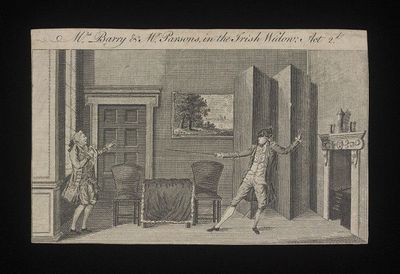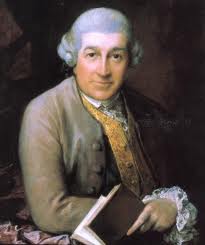Annotation:Irish Widow: Difference between revisions
No edit summary |
No edit summary |
||
| Line 5: | Line 5: | ||
<br> | <br> | ||
<br> | <br> | ||
[[File:garrick.jpg| | [[File:garrick.jpg|550px|thumb|left|David Garrick]] | ||
'''The Irish Widow''' is the name of a comic play written by actor, playwright and impresario David Garrick (1717-1779) and was first staged at Drury Lane Theatre in 1772. Garrick wrote it in a week, loosely based on the plot of '''Le Mariage forcé''' by Molière. It proved successful and popular, and was staged intermittently for the next 50 years. | '''The Irish Widow''' is the name of a comic play written by actor, playwright and impresario David Garrick (1717-1779) and was first staged at Drury Lane Theatre in 1772. Garrick wrote it in a week, loosely based on the plot of '''Le Mariage forcé''' by Molière. It proved successful and popular, and was staged intermittently for the next 50 years. | ||
<br> | <br> | ||
Revision as of 23:29, 7 February 2018
Back to Irish Widow
IRISH WIDOW. English, Country Dance Tune and Jig (6/8 time). F Major. Standard tuning (fiddle). AABB. The "Irish Widow" was a popular country dance tune that appears in numerous late 18th century publications and musicians' manuscript collections. In print, it can be found in Charles and Samuel Thompson's Compleat Tutor for the Fife (c. 1770), Charles and Samuel Thompson's Thompson's Compleat Collection of 200 Country Dances, vol. 4 (1780), Thomas Skillern's Compleat Instructions for the Fife (1780), Thomas Skillern's Skillern's Compleat Collection of Two Hundred & Four Reels (1780), Longman & Broderip's Entire New and Compleat Instructions for the Fife (1780), and similar publications.


The Irish Widow is the name of a comic play written by actor, playwright and impresario David Garrick (1717-1779) and was first staged at Drury Lane Theatre in 1772. Garrick wrote it in a week, loosely based on the plot of Le Mariage forcé by Molière. It proved successful and popular, and was staged intermittently for the next 50 years.
Source for notated version:
Printed sources: Straight and Skillern (Two Hundred and Four Favourite Country Dances, vol. 1), c. 1775; No. 49, p. 25. Samuel, Ann & Peter Thompson (The Hibernian Muse), 1787; No. 90, p. 55.
Recorded sources:
